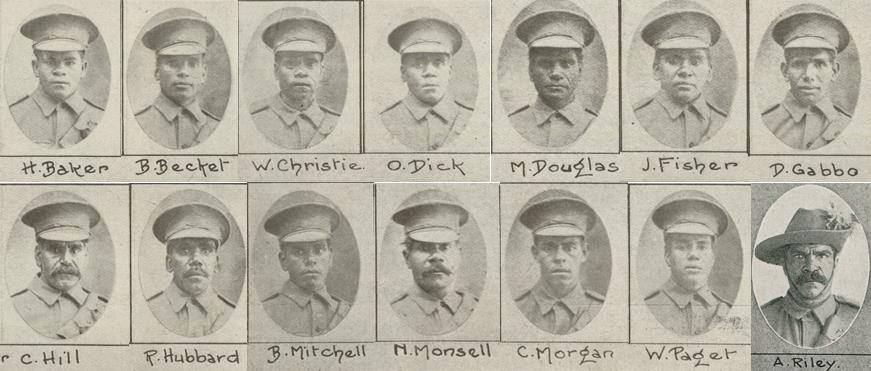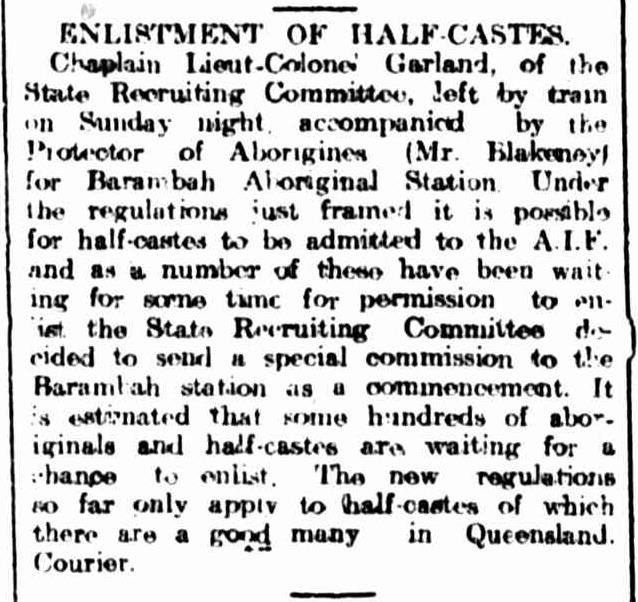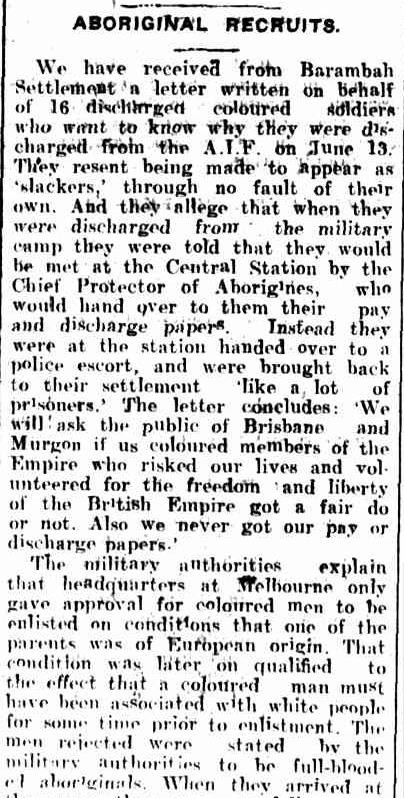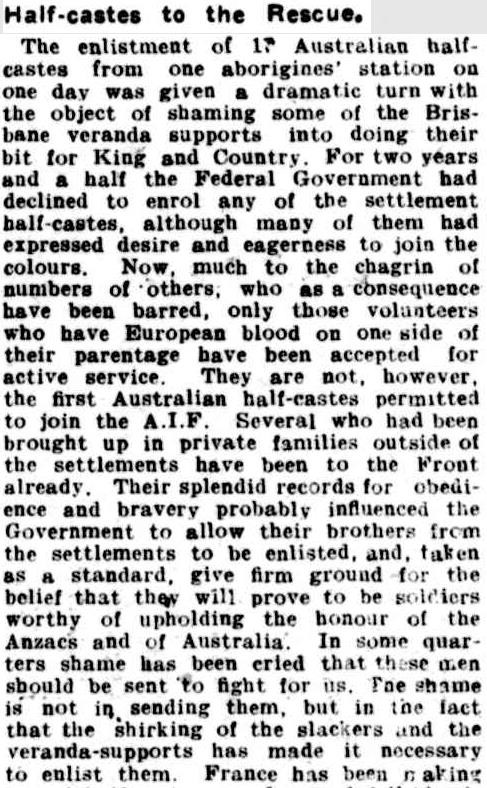In May 1917, the Australian Government issued a Military Order (No. 200) which relaxed the Defence Act (1903) provisions around indigenous enlistment. A resounding ‘No’ vote in the 1916 conscription referendum, heavy losses on the Western Front, and a decreasing number of willing recruits, prompted authorities to consider other strategies to fulfill the recruiting quota.
“Persons who are not substantially of European origin or descent” were exempt under the Defence Act, however the 1917 Military Order stated that “half castes may be enlisted in the Australian Imperial Force provided that the examining Medical Officers are satisfied that one of the parents is of European origin”. Although a halfway measure, this change did enable more aboriginal men to join the AIF.

Indigenous men had in fact been enlisting since 1914, but success was random, and often dependent on the attitudes of recruiting sergeant and officers, and how they interpreted and applied the Instructions for the guidance of enlisting officers at approved military recruiting depots - “Aboriginals, half-casts, or men with Asiatic blood are not to be enlisted – This applies to all coloured men.”
Some indigenous men travelled hundreds of miles to try their luck at recruiting centres far away from their communities, if they had been rejected closer to home. Others with mixed parentage scraped through by claiming foreign nationality. Some men who were successfully enlisted were subsequently rejected once they arrived at a training camp.
Such was the case for a group of indigenous men from Queensland. On 15 May 1917, the Darling Downs Gazette reported that Canon Garland of the State Recruiting Committee and Mr Blakeney, the Protector of Aborigines, informed of the new regulations, travelled to the Barambah Aboriginal Station to enlist several aboriginal men who had been ‘waiting for some time for permission’.

'Enlistment of half-castes', Darling Downs Gazette, 15 May 1917, p.4
On the 21 June 1917 however, the Gazette reported that the 16 men had been rejected and sent back home. Upon arrival at the training camp they had been examined by a medical officer and deemed ‘unfit for military duties’, as they were ‘not half-castes, and the military authorities state that full-blooded aboriginals are not wanted, as they will not make soldiers.’ Angry that they were ‘made to appear as slackers’, the men wrote a letter to the Brisbane Courier stating that not only had they been escorted home ‘like a lot of prisoners’, but had also not received any pay or discharge papers.

'Aboriginal recruits' Darling Downs Gazette, 21 June 1917, p.6
Certainly, the prospect of increased indigenous enlistment met with a variety of opinion. A particularly patronising article in The Queenslander on Saturday 2 June 1917 – ‘Half-castes to the rescue’ - appeared to praise the honour and bravery of indigenous servicemen, however its main point seemed to be a criticism of indifferent young white men, complaining that the 'shirking of the slackers and the veranda-supports has made it necessary to enlist' indigenous men.'

'Half-castes to the rescue'. The Queenslander , 2 June 1917, p.20
The author suggested that it was a 'shamefully regrettable circumstance that we should have to go back to the blacks for defensive purposes, and it brings us face to face with the degrading fact that Australia has given birth to numbers of young whites who would rather foist their war responsibilities on to anybody else rather than face the music themselves.' For young black men, the enlistment changes of 1917 offered some leeway for participation in the war, however equality was nowhere to be found.
For more information about Queensland's indigenous servicemen, see the QANZAC100 website.
References
Defence Act 1903
Military Order No. 200, May 1917
Instructions for the guidance of enlisting officers at approved military recruiting depots. Anthony James Cumming Government Printer and the Australian Army, Brisbane, 1916. Australian War Memorial, 355.2230994 A741r
The boys from Barambah : the story of the black diggers of Barambah-Cherbourg of World War 1. by Mark Newman, Sally Lawrence and Philippa Scarlett with assistance from Tanya Schneider and the ANZAC 100 Boys from Barambah Committee. State Library of Queensland, JUV Q 940.400899915 NEW
Robyn Hamilton - QANZAC100 Content Curator, State Library of Queensland
Comments
Your email address will not be published.
We welcome relevant, respectful comments.